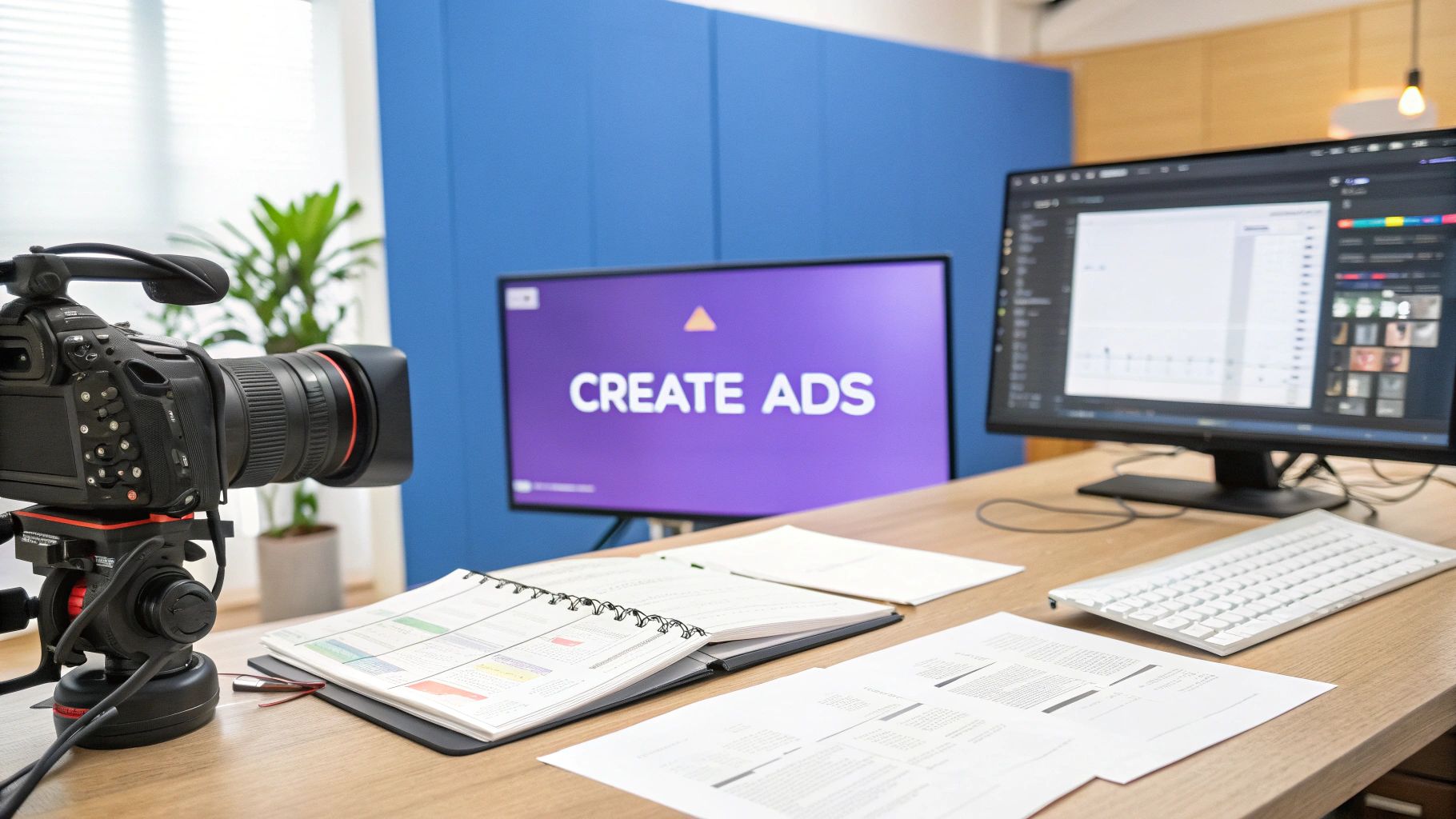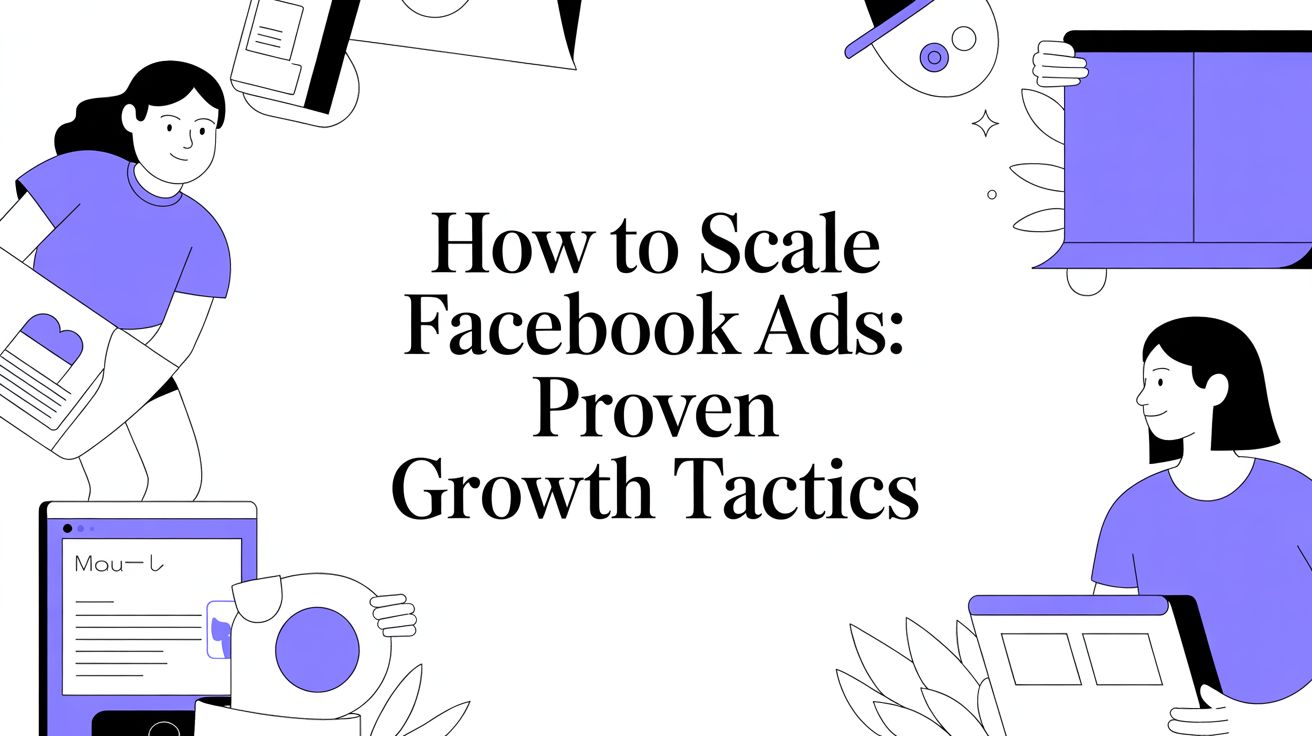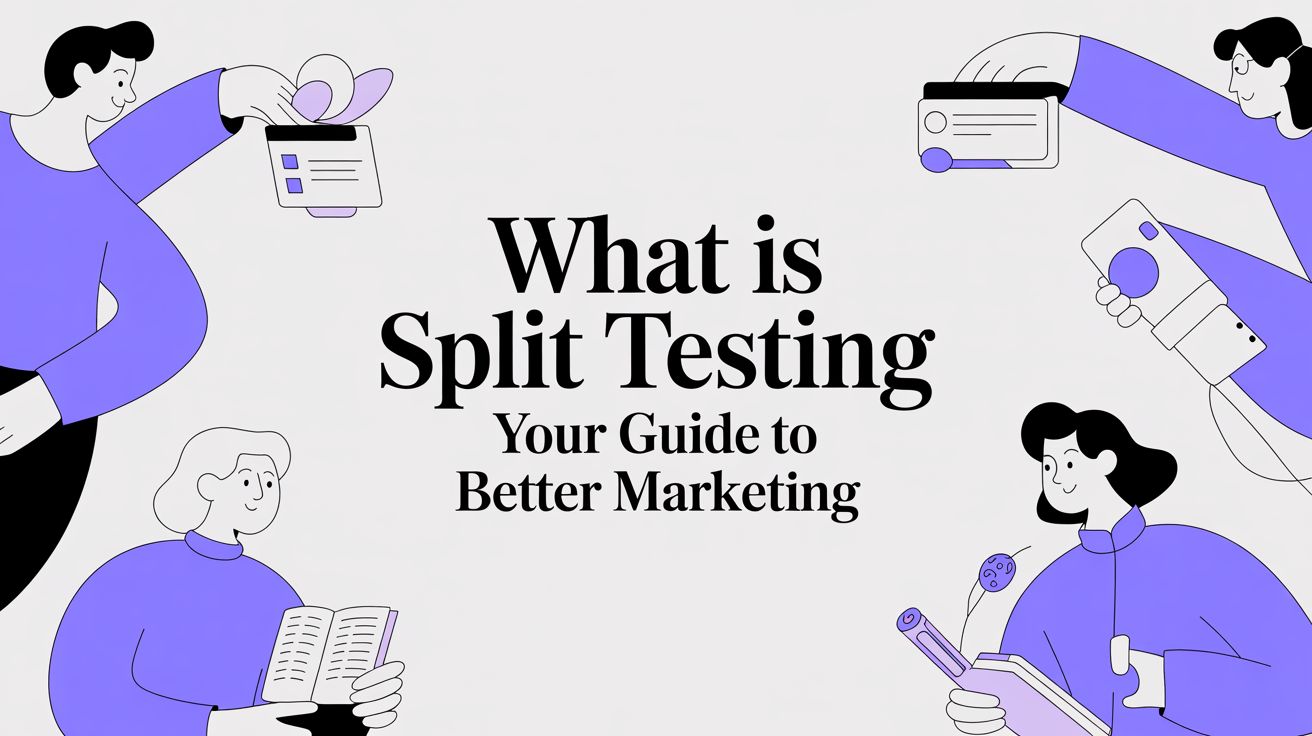Making a great commercial isn't about huge budgets and month-long production schedules anymore. These days, you can create ads with real impact by starting with a strong core message, using an AI video generator to bring it to life, and getting it in front of the right people on digital platforms. It's a modern blend of smart scripting and powerful, accessible technology.
The New Era of Commercials: Why Your Strategy Must Adapt

Let's be honest—the old way of making commercials is on its way out. The classic model of expensive film shoots, massive crews, and drawn-out logistics is being replaced by something much nimbler and digital-first. Today, winning is all about speed, relevance, and showing up where your audience actually spends their time: scrolling through social media and binging online videos.
The money tells the story. With global digital ad spending expected to rocket past $700 billion by 2025, the game is being played almost entirely online. Video ads crush other formats in performance, and social media now soaks up nearly 40% of all digital ad spending. If you want to make commercials that truly work, you have to get your head around these numbers.
Modern Commercial Creation: Key Shifts
To really grasp how much has changed, let's look at the old way versus the new. The rise of AI and digital platforms has completely rewritten the playbook for creating commercials, shifting the focus from big productions to smart, efficient execution.
| Aspect | Traditional Approach | Modern AI-Powered Approach |
|---|---|---|
| Production Cost | Extremely high, requiring crews, locations, and expensive gear. | Dramatically lower, often just a software subscription. |
| Timeline | Months of planning, shooting, and post-production. | Hours or days, from script to final video. |
| Accessibility | Limited to large brands with significant marketing budgets. | Open to anyone—from startups to solo creators. |
| Distribution | Focused on broad television slots with limited targeting. | Highly targeted ads for specific platforms and demographics. |
| Flexibility | One-and-done campaigns that are difficult to change. | Rapid testing, iteration, and continuous optimization. |
This table really just scratches the surface. The entire mindset has changed from creating a single, perfect ad to launching multiple variations quickly to see what sticks.
Why This Matters for You
The biggest shift? The barriers to entry have crumbled. Professional-quality video production is no longer a walled garden reserved for companies with deep pockets. AI tools put incredible creative power right at your fingertips.
This new reality offers a few incredible advantages:
- Unbelievable Speed: Timelines have shrunk from months to, in some cases, a single afternoon. This allows you to react to trends and test ideas almost instantly.
- Pinpoint Focus: The goal isn't a one-size-fits-all TV spot anymore. It's about creating tailored ads for TikTok, Instagram Stories, or YouTube pre-roll.
- Democratized Creativity: You don't need a film crew. You just need a good idea. The tools handle the heavy lifting, giving you a direct line to tell your brand's story.
The takeaway is simple: What once required a small army can now be done from your laptop. That's a massive shift in power, putting you in the driver's seat.
For some broader insights into commercials and how their role continues to evolve, that's a great read. But for now, let's dive into the practical side. This guide will walk you through exactly how to adapt and create ads that don't just get views, but get results.
Crafting Your Core Message and Script
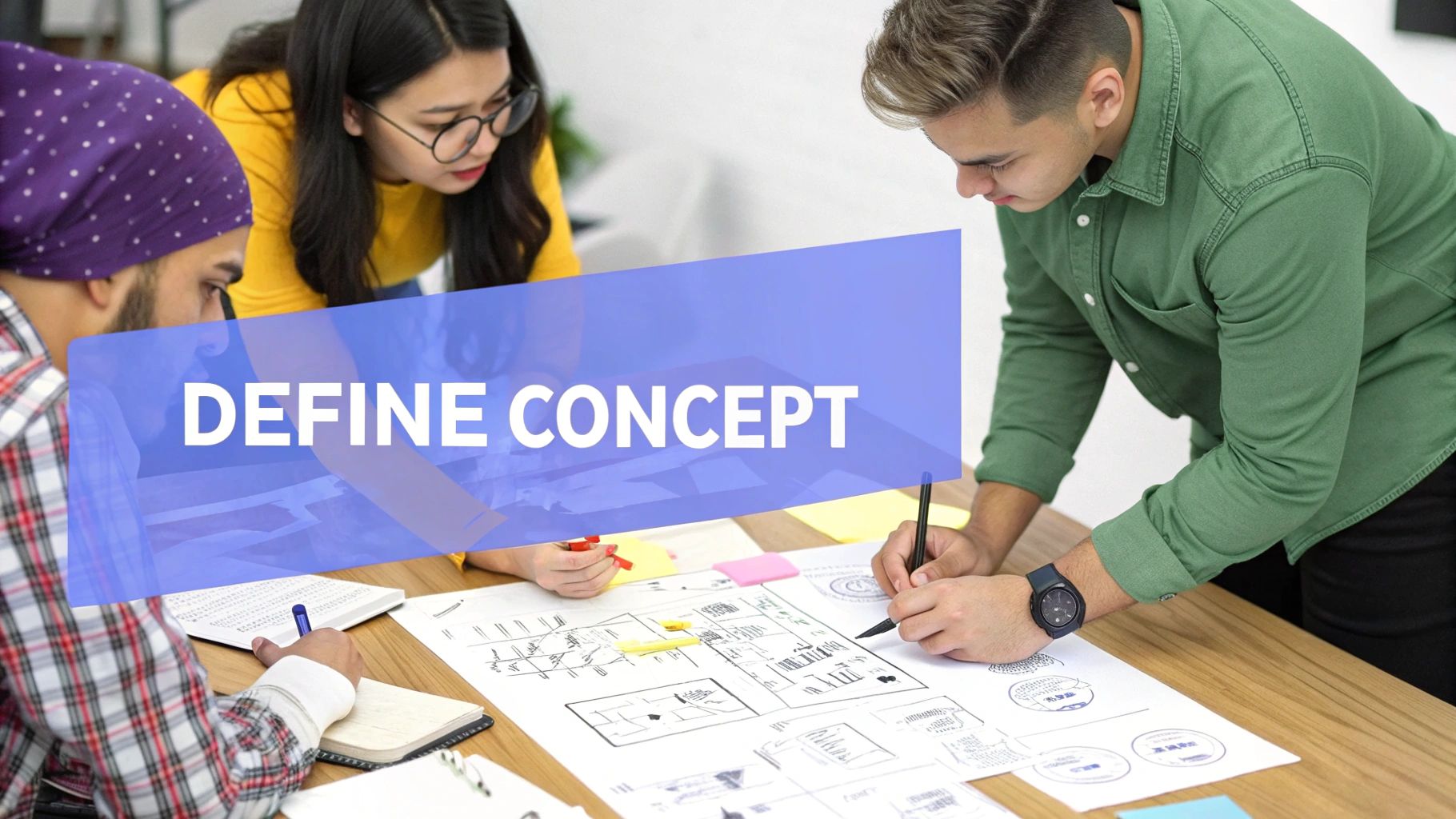
Before you ever touch an AI video generator, you need to build your commercial's foundation with words. A solid concept and a sharp script are your blueprints for success. This goes way beyond just dialogue; it's about the story you’re trying to tell and the feeling you want to leave with your audience in a handful of seconds.
It all starts with a simple but crucial question: who are you really talking to? The answer dictates everything—your tone, your visuals, even your sense of humor. Getting a firm grip on how to find your target audience isn't just a marketing exercise; it’s the first step in any creative process. After all, a commercial for a new gaming headset should feel worlds apart from one for a retirement planning service.
The Four-Part Commercial Framework
From my experience, the most effective digital commercials stick to a simple, time-tested structure. Think of it as a mini four-act play that has to grab, engage, and convert, often in less than 30 seconds. This framework is your secret weapon when scripting for an AI video platform.
Here’s how it breaks down:
- The Hook (0-3 seconds): You have a blink of an eye to stop someone from scrolling. Hit them with a surprising question, a stunning visual, or a pain point they know all too well. A coffee brand shouldn't just show coffee beans; they should show a person looking like a zombie before their first glorious cup. That’s a hook.
- The Problem (3-10 seconds): Now that you have their attention, clearly state the problem your audience faces. This is where you build a real connection. If you're selling a project management tool, you could show quick, chaotic cuts of overflowing email inboxes and missed deadlines.
- The Solution (10-20 seconds): This is where your product rides in like a hero. Don’t just say it’s the solution—show it. That chaotic office scene? Replace it with a shot of a clean, organized dashboard, bringing a sense of calm and control.
- The Call to Action (20-30 seconds): Be direct. Tell them precisely what you want them to do next. “Learn More,” “Shop Now,” or “Download the App.” Make it impossible to miss, using both a clear voiceover and bold on-screen text.
A great script isn't about winning literary awards; it's about achieving clarity and persuasion in as few words as possible. Your goal is to move someone from passive viewer to active customer.
Writing for AI Video Production
Scripting for an AI tool requires a slightly different mindset. You need to think less like a writer and more like a director giving commands. Your script really needs two distinct parts: what the audience hears and what the AI "sees."
- Voiceover Script: This is the dialogue. Keep it tight and conversational. Read every line out loud—you'll immediately catch any clunky phrases or words that don't flow naturally.
- Visual Prompts: This is your shot list for the AI. The more descriptive you are, the better the result. Don't just write, "Show a happy customer." Instead, try: "A young woman with curly hair smiles as she unboxes a sleek, white product in a brightly lit, modern apartment."
That level of detail gives the AI concrete instructions to work with, ensuring the visuals actually match the story in your head. Thinking in shots like this from the start also helps you build a more dynamic ad and makes it incredibly easy to create different versions for A/B testing later on.
If you want to get even deeper into the nuts and bolts of this process, our guide on how to create AI video ads has more specific strategies for turning your script into a polished, high-performing commercial.
Using an AI Video Generator to Produce Your Ad
Alright, you’ve got a solid script. Now for the fun part: turning those words into a living, breathing commercial. This is where AI video platforms really shine. Forget the old days of complex, intimidating software—think of these tools as your creative co-pilot, ready to execute your vision.
The real magic happens when you translate your script into effective prompts for the AI. This is probably the most crucial skill to learn. A great prompt is the difference between a generic, forgettable clip and a scene that genuinely captures the emotion you've been imagining.
This visual shows how the core steps of scriptwriting directly feed into the AI generation process.
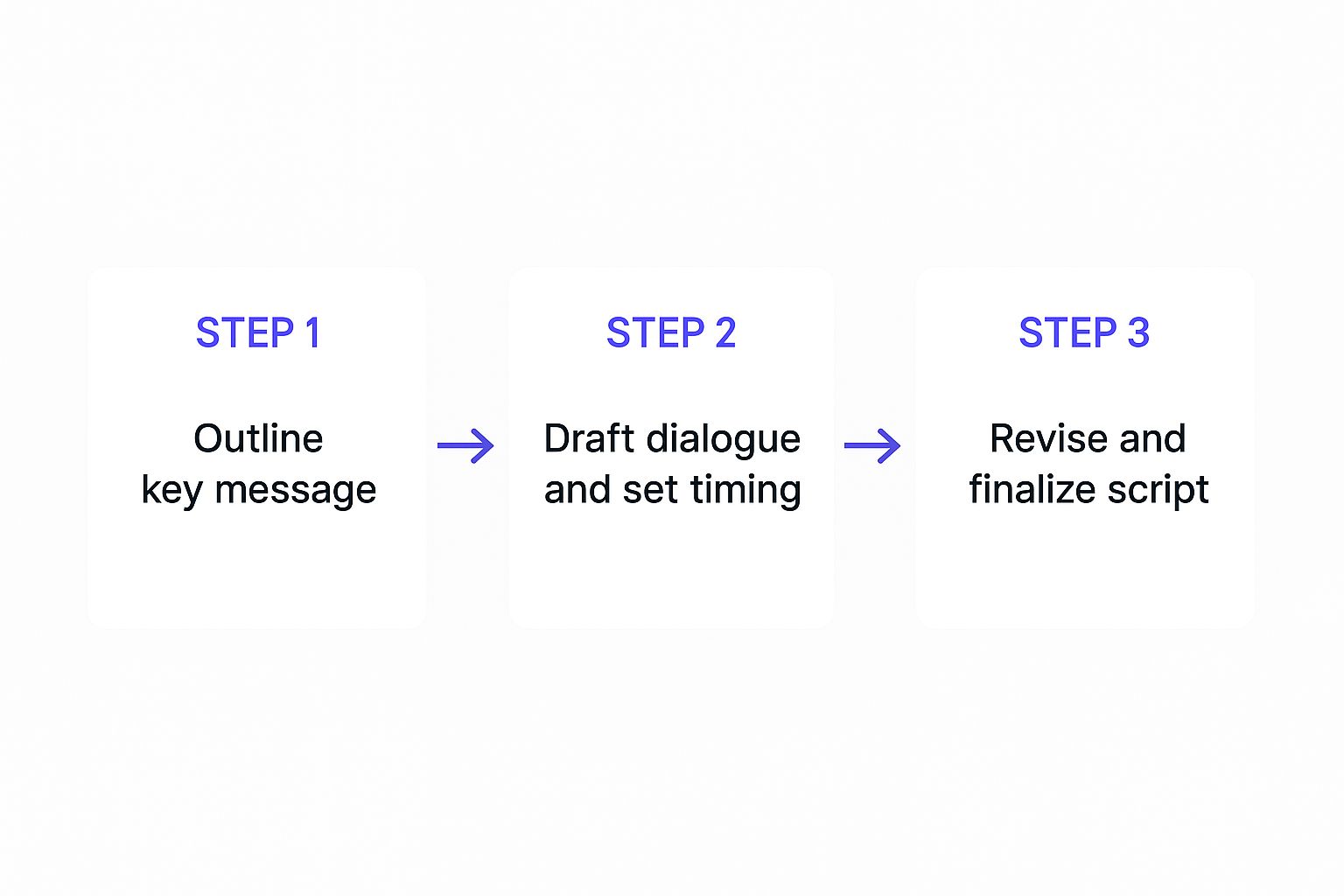
Each stage, from mapping out your message to polishing the final script, sets you up for success. By the time you start generating, your visual and narrative ideas are already perfectly aligned.
From Script to Scene Generation
Your script's visual notes are the perfect starting point for your AI prompts. Let’s walk through a real-world example. Imagine we're creating a commercial for a new brand of sustainable, plant-based protein bars called "Evergreen."
Our script opens with a scene described simply as: "A tired office worker, mid-30s, slumps at their desk under harsh fluorescent lighting, looking drained."
That's a good start, but to get a great result from the AI, we need to add more directorial detail. A much better prompt would look something like this:
Prompt Example: A medium shot of a man in his mid-30s with tired eyes, slumped over a cluttered desk in a sterile, modern office. The lighting is cold and fluorescent. He rubs his temples, looking completely drained of energy. Photorealistic style, 4K.
See the difference? This level of detail gives the AI specific instructions on the character's appearance, their actions, and the mood you want to create.
Picking Your AI Avatar and Voice
One of the best features of platforms like Synthesia is the ability to use AI-generated avatars and voiceovers. This completely sidesteps the need to hire actors or book a recording studio, saving a ton of time and money.
For our "Evergreen" commercial, we'd want an avatar that feels relatable and authentic—someone our audience would trust. Not a slick corporate type. The key is to be consistent; stick with the same avatar throughout your ad to build a clear narrative.
Generating the voiceover is just as simple. You paste your dialogue into the tool, pick a voice style, and tweak the pacing.
Here are a few tips from my own experience:
- Match the voice to your brand. Are you energetic and fun, or calm and reassuring? The voice should reflect that personality.
- Listen to the generated audio closely. You can often add small pauses or adjust pronunciations to make the delivery sound much more natural. It's a small step that makes a huge impact.
- Give your visuals room to breathe. I always let scenes run a bit longer than the dialogue. This gives you much-needed flexibility when you get to editing.
Controlling the Visual Style
Your prompts are your main tool for dialing in the ad's visual aesthetic. Subtle changes in your keywords can produce wildly different results. For our "Evergreen" ad, we want the "after" shots—where our hero eats the protein bar—to feel warm and natural.
Here’s how a prompt can achieve that:
Prompt Example: The same man now sits in a park on a sunny day, smiling and looking energized as he takes a bite of a protein bar. The scene is shot with a shallow depth of field, with warm, golden hour lighting. Lush green trees are blurred in the background. Cinematic, uplifting mood.
This is what you might see inside an AI video platform. The interfaces are designed to be incredibly user-friendly, allowing you to simply type in your text, choose an avatar, and generate your video.

The simplicity here is intentional. These tools are built to make video production something anyone can do, not just seasoned professionals.
By getting good at writing prompts and making smart use of the built-in avatar and voice features, you can produce a high-quality commercial from scratch. You're literally turning a script into a compelling story without ever touching a camera.
Refining and Polishing Your AI-Generated Commercial
Think of the video clips from your AI generator as raw clay. It's a fantastic starting point, but the real artistry happens when you start shaping it. This is the post-production stage, where you add the essential human touch that turns a collection of scenes into a persuasive and polished commercial.
Frankly, this is where you take back full creative control.
The first thing I always tackle is the pacing. Getting the rhythm right is everything. Even a half-second of awkward timing can make a viewer lose interest and scroll right past. Go through your timeline and be absolutely ruthless. Trim any dead air, cut any shot that lingers too long, and make sure every transition feels intentional and smooth.
Key Takeaway: You're aiming for a seamless flow. A well-paced ad feels shorter than it actually is, keeping the viewer hooked from the first second to the last.
With the pacing locked in, it's time to build the emotional backbone with sound. I've seen it time and time again: the audio of a commercial is often more powerful than the visuals. The right background music can completely transform the mood, making a scene feel inspiring, urgent, or deeply touching.
Enhancing the Visual and Audio Experience
Beyond the music, you need to think about sound design. These are the subtle effects that make your ad feel real and immersive. The crisp click of a product lid closing, the soft whoosh of a transition, or the gentle hum of an office—these small details add a layer of polish that screams professional.
Next up, let's get the visuals looking consistent.
- Color Grading: AI clips, especially from different prompts, can sometimes have slight differences in color and lighting. Applying a single, consistent color grade across the entire video ties everything together. It makes the ad look like it was shot with a single vision, not just assembled.
- Branded Assets: Now, weave in your brand. Add your logo, use your brand colors in text overlays, and stick to your brand fonts. A small, persistent logo in the corner reinforces who you are, while text can hammer home key selling points or your call to action.
Making Your Commercial Accessible and Effective
Here’s a hard truth: a huge percentage of people watch videos on social media with the sound off. This means subtitles are absolutely mandatory. Adding clear, legible captions ensures your message gets across no matter how someone is watching. It’s a simple step that can massively boost comprehension and engagement.
This is also the perfect time to create different versions for A/B testing. It's easy to swap out the music, tweak the text on the final call to action, or even reorder a couple of scenes to see what resonates most with your audience. For a deeper dive into creating ad variations and testing them, our complete guide on how to make video ads is a great resource.
By spending time on these final touches, you're elevating your AI-generated footage into a genuinely powerful marketing tool. It’s this final 10% of polish that makes all the difference, ensuring your commercial doesn't just look good, but actually works.
Distributing Your Ad for Maximum Reach and Impact
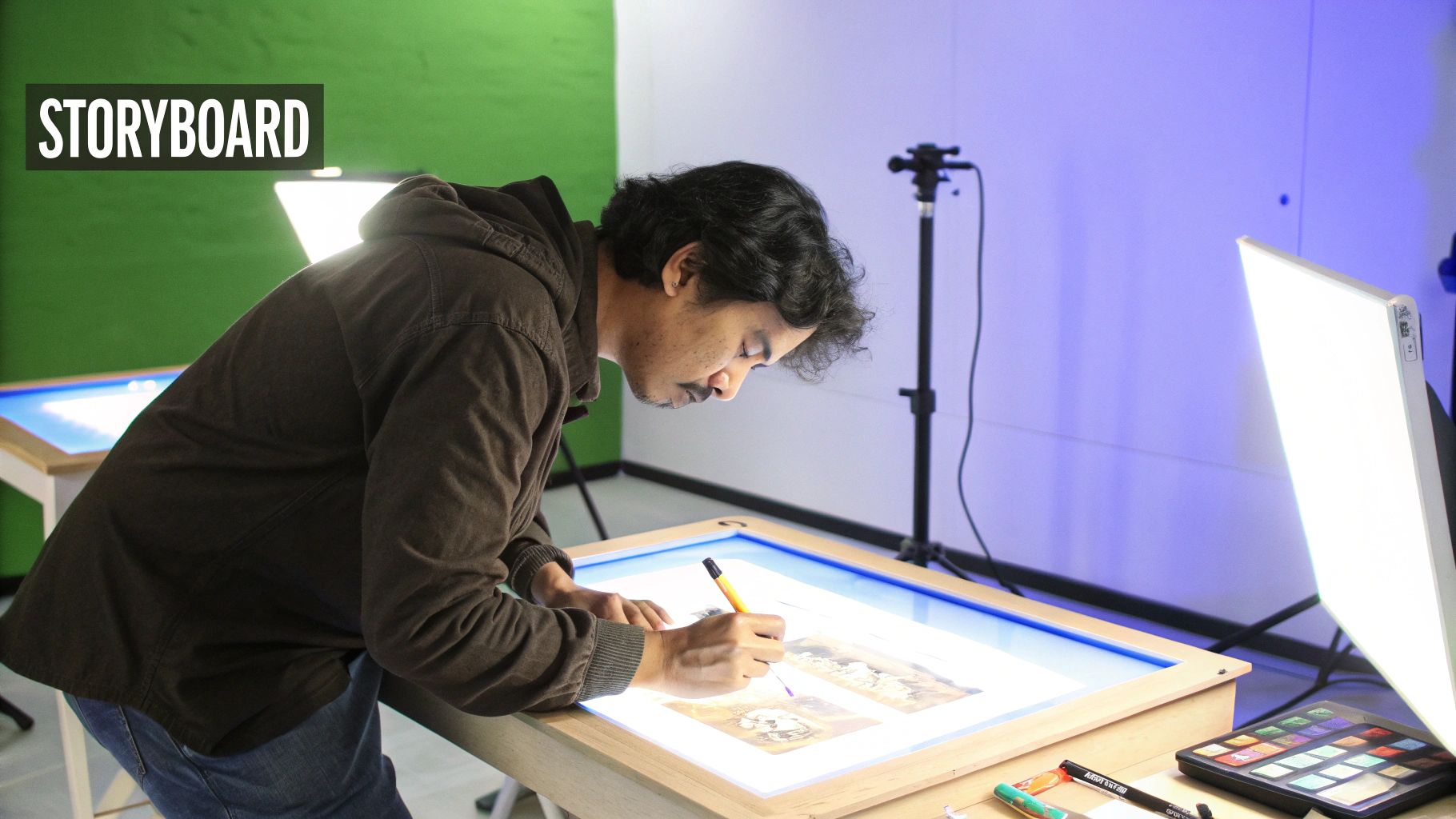
You can create the most incredible commercial in the world, but if the right people don't see it, it's just a wasted effort. I've seen it happen. Production is really only half the job. Getting actual results comes down to smart, strategic distribution.
This isn't about just throwing your ad out there and hoping for the best. It’s about being deliberate, placing it exactly where your ideal customers are already scrolling, watching, and engaging. A good distribution plan uses a mix of paid and organic strategies. Paid ads get you in front of people fast, while organic methods build a more lasting connection with your audience.
Choosing the Right Platforms
Every social platform has its own personality and its own audience expectations. A commercial that kills it on TikTok could easily get ignored on YouTube. The real trick is to match your ad's vibe to the platform's culture.
Here’s a quick rundown of the main players I focus on for video ads:
- YouTube: This is your spot for longer, more in-depth stories. Think product tutorials, detailed brand narratives, or "how-to" videos that solve a real problem. The targeting here is second to none; you can zero in on people based on exactly what they're searching for and watching.
- Instagram & Facebook: These platforms are all about visual appeal. Your ads need to look great and feel right at home in a user's feed. Reels and Stories are perfect for quick, punchy commercials that grab attention instantly, making them a goldmine for e-commerce and driving sales.
- TikTok: Welcome to the land of trends and authenticity. The polished, super-produced ad often feels out of place here. To succeed, you need to embrace a more raw, user-generated content (UGC) style. It’s a fantastic way to build brand awareness, especially with younger audiences.
My Two Cents: Never just copy and paste the same video file everywhere. That 60-second masterpiece you made for YouTube? It needs to be recut into a snappy, vertical 15-second clip for Instagram Stories. Tailoring the format shows you actually get the platform and respect the user’s time.
Setting Up Your Paid Ad Campaign
Diving into paid ads can feel like a lot at first, but it really comes down to a few key decisions. Your main job is to give the platform’s algorithm a clear roadmap: who to show your ad to and what you want them to do next.
First, get laser-focused on your target audience. Don't just stop at age and location. Dig into their interests, their online habits, even the other brands and creators they follow. The more specific your targeting, the less money you'll waste on people who will never buy.
Next, you need a realistic budget and a clear campaign objective. Are you trying to get clicks to your website? Generate leads for your sales team? Or make direct sales? Pick the one that matters most, because that tells the platform's algorithm how to measure success and optimize your campaign.
It also helps to know where the money is flowing. Global ad spend forecasts, for example, show the Asia-Pacific region is projected to have a 6.0% growth rate in 2025. Knowing this could influence where you focus your efforts. For anyone who geeks out on this stuff, Dentsu has some great 2025 ad spend forecasts you can check out.
Leveraging Organic Distribution Channels
Paid ads are great, but don't forget about your free channels. These are your owned properties where you can get your commercial seen without spending an extra dime.
Start by embedding your new video on your website. Put it on high-traffic pages like your homepage or a key product page. It instantly makes the page more engaging and can give your conversion rates a nice little bump.
Your email list is another powerhouse. Send out a campaign to your subscribers showcasing the new commercial. This is a perfect way to re-engage your most loyal fans and warm up potential customers. If you want more ideas, we’ve put together a guide on other video distribution platforms.
Frequently Asked Questions About Creating Commercials
Diving into making commercials, especially with new AI tools, always brings up a few questions. I've heard these a lot, so I've put together some straight-to-the-point answers to help you get started with confidence.
How Much Does It Cost to Create a Commercial with AI?
This is usually the first question people ask, and the answer is a game-changer. Forget the traditional production costs that can easily run into the tens of thousands. With AI video platforms, you're looking at the cost of a software subscription—often somewhere between $30 to $100 per month.
This completely levels the playing field, especially for small businesses or startups. That massive financial hurdle to creating a professional-looking ad? It's pretty much gone. Now you can produce high-quality work, even on a shoestring budget.
Do I Need Any Special Skills to Use These Tools?
Honestly, no. If you can type out an email or a social media update, you've got what it takes. The real skill is learning to write clear and descriptive prompts. Think of it as simply telling the AI exactly what you envision.
The learning curve is surprisingly gentle. Most people I've seen go from signing up to creating their first finished commercial in just a couple of hours. It’s far more about your creative ideas than it is about technical wizardry.
How Do I Know If My Commercial Is Actually Working?
This is the most important part. If you're not measuring performance, you're just throwing money away. The first step is to know what "working" means for you. Are you trying to build brand awareness, drive traffic to your website, or get direct sales?
Once you have your goal, you can track the right metrics. Keep an eye on things like:
- Click-Through Rate (CTR): What percentage of people who see your ad actually click it?
- Conversion Rate: Of those who click, how many follow through and make a purchase or sign up?
- View-Through Rate (VTR): Are people watching the whole video, or are they dropping off after a few seconds?
To really connect the dots, it’s worth your time to measure marketing attribution and prove ROI. This helps you see exactly which ads are leading to sales, giving you a crystal-clear picture of what’s effective. The great thing about digital ads is the instant feedback—you get data you can use to tweak and improve your strategy right away.
Ready to stop worrying about complex production and start creating high-performing video ads in minutes? Sprello empowers you to produce engaging, UGC-style commercials with AI, no actors or editing skills required. Start your free trial and see how easy it is to bring your ideas to life at https://sprello.ai.
